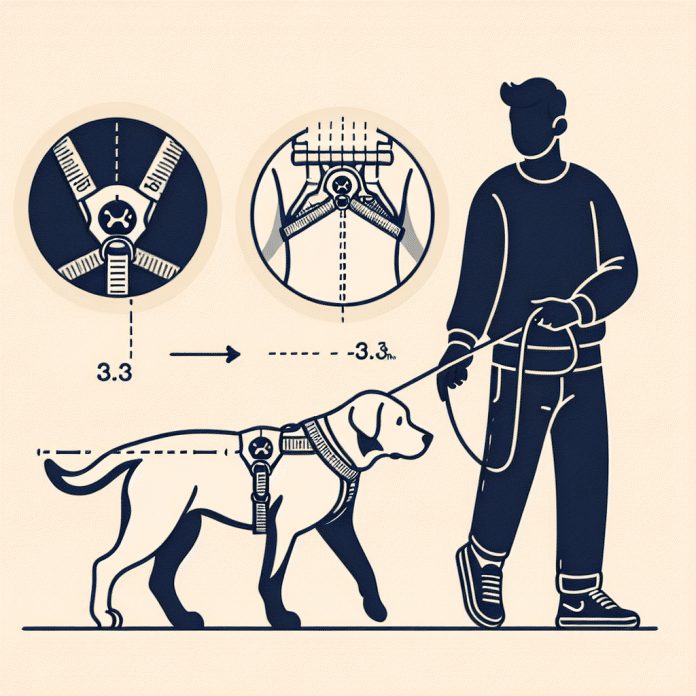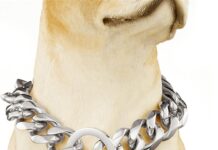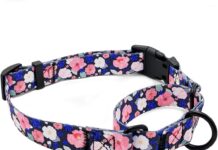If you’ve ever found yourself standing in a pet store aisle, utterly befuddled by the array of dog harness sizes, you’re not alone. We’ve all been there, wondering which size would be the best fit for our furry friends. But fear not! In this article, we’ll guide you through the process of finding the perfect dog harness size, ensuring maximum comfort and safety for your four-legged companion. Say goodbye to confusion and hello to a stress-free shopping experience!
Importance of Finding the Right Dog Harness Size
Finding the right dog harness size is crucial for the comfort and well-being of your furry friend. It ensures that your dog can move freely and comfortably without any restrictions or discomfort. Here are some key reasons why finding the correct harness size is so important:
Ensures Comfort for Your Dog
Just like us, dogs also need to feel comfortable in their clothes, or in this case, their harnesses. A properly fitting harness should not be too tight or too loose, as it can cause discomfort and even pain for your dog. It should allow enough room for your dog to breathe and move naturally, preventing any restrictions or chafing.
Prevents Chafing and Rubbing
A harness that is too tight can cause chafing and rubbing against your dog’s skin, leading to irritation and potential injuries. On the other hand, a harness that is too loose can shift and rub against sensitive areas, causing discomfort and soreness. By finding the right harness size, you can prevent these issues and ensure that your dog remains happy and irritation-free.
Allows Proper Control and Training
Having the right size harness is essential for maintaining proper control over your dog. A harness that is too big or too small may not provide enough control during walks or training sessions, making it difficult to manage your dog’s behavior. By having a properly fitting harness, you can have better control over your dog’s movements, ensuring their safety and the safety of others around them.
Ensures Safety and Security
One of the most important reasons for finding the right dog harness size is to ensure your dog’s safety and security. A well-fitting harness reduces the risk of your dog slipping out of it or escaping during walks. It also helps prevent injuries by distributing the force evenly across their body in case of sudden movements or pulling. A harness that is too loose could potentially allow your dog to slip out of it, while a harness that is too tight may cause discomfort and even restrict their breathing. Therefore, finding the correct size is crucial for your dog’s overall safety and security.
Factors to Consider When Choosing a Dog Harness Size
Choosing the right dog harness size involves taking into account various factors related to your dog’s breed, age, body shape, weight, and activity level. Here are some key factors to consider:
Dog Breed and Size
Different dog breeds have different body structures and sizes, so it is important to consider your dog’s breed when choosing a harness size. Smaller breeds, such as Chihuahuas or Dachshunds, will require smaller harness sizes, while larger breeds, such as Labradors or Great Danes, will need larger harness sizes to comfortably fit their bodies.
Age and Growth Stage
Puppies grow rapidly, so it is crucial to take their age and growth stage into account when choosing a harness size. Adjustable harnesses are often recommended for puppies, as they can be resized as the puppy grows. Additionally, senior dogs may have different comfort needs, so consider their age when selecting a harness size.
Body Shape and Proportions
Every dog has a unique body shape and proportions, even within the same breed. Some dogs may have broader chests or longer bodies, which can affect the fit of the harness. It is important to consider your dog’s body shape and proportions when choosing a harness size to ensure a proper fit.
Weight and Height Measurements
Taking accurate weight and height measurements of your dog is essential for finding the right harness size. Some harnesses may have weight or size limitations, so knowing your dog’s measurements will help you choose the appropriate size.
Activity Level and Energy
Dogs with high activity levels or energy may benefit from a different harness design or size to accommodate their movement. Consider your dog’s activity level when selecting a harness size to ensure they have the freedom to move comfortably during walks or other activities.
Health and Physical Conditions
If your dog has any health or physical conditions, such as arthritis or back problems, it is important to choose a harness that provides adequate support and doesn’t exacerbate their condition. Consulting with your veterinarian for guidance on selecting the right harness size can be beneficial in these cases.
Measuring Your Dog for a Harness
Measuring your dog for a harness is a relatively simple process that can be done at home. Here are some steps to follow:
Using a Measuring Tape
Using a flexible measuring tape, measure various areas of your dog’s body to determine their size accurately. Make sure not to pull the tape too tightly or leave it loose, as this can result in inaccurate measurements.
Identifying Key Measurements
For most harnesses, the key measurements to consider are the chest circumference and the neck circumference. To measure the chest circumference, wrap the measuring tape around the widest part of your dog’s chest, just behind the front legs. To measure the neck circumference, wrap the measuring tape around the base of your dog’s neck, where the collar would sit.
Following Manufacturer Guidelines
Different harness manufacturers may have specific guidelines for measuring your dog, so it is always a good idea to refer to their instructions. They may provide additional measurements, such as the length of your dog’s body, to ensure a proper fit.
Checking for Adjustability
When choosing a harness, it is beneficial to look for adjustable features, such as straps or buckles, that allow you to customize the fit. This is especially important for puppies or dogs that are still growing, as it allows you to resize the harness as needed.
Types of Dog Harnesses
There are various types of dog harnesses available, each offering different benefits and functionalities. Here are a few common types of dog harnesses to consider:
Step-In Harness
A step-in harness is designed to be placed on the ground, and your dog steps into it with each leg. It usually has two separate pieces that are connected on the dog’s back. Step-in harnesses are easy to put on and take off, making them a popular choice for many dog owners.
Over-the-Head Harness
An over-the-head harness is placed over your dog’s head and rests on their shoulders. It is secured with straps that go around the chest and underneath the front legs. This type of harness provides good support and control, especially for dogs that tend to pull during walks.
Vest Harness
A vest harness is similar to an over-the-head harness but covers more of your dog’s body, resembling a vest. It provides more coverage and support, making it a suitable option for dogs with specific needs, such as elderly dogs or those with back problems.
No-Pull Harness
A no-pull harness is designed to discourage dogs from pulling during walks. It typically has a front-clip attachment point, which redirects the dog’s pulling force towards the side, preventing them from moving forward. This type of harness can be effective for dogs that tend to pull excessively.
Front-Clip Harness
A front-clip harness has the attachment point on the front of the dog’s chest. This harness design helps redirect your dog’s pulling force towards the side, making it easier to control their movements. It also encourages dogs to walk beside you, instead of pulling ahead.
Choosing the Right Harness Size
Choosing the right harness size involves considering your dog’s breed, age, body shape, and accurate measurements. Here are some steps to help you choose the right harness size:
Referencing Breed and Size Charts
Many harness manufacturers provide breed and size charts, which can serve as a useful starting point for finding the right harness size for your dog. These charts often suggest harness sizes based on average measurements for different breeds. However, keep in mind that every dog is unique, and individual measurements may vary.
Considering the Age and Growth Stage
For puppies, it is important to consider their age and growth stage when selecting a harness size. Adjustable harnesses are ideal for accommodating their growth and ensuring a proper fit as they develop. Older dogs may require a harness size that meets their comfort needs, accounting for any age-related conditions or limitations.
Factoring in Body Shape and Proportions
When choosing a harness size, it is essential to take into account your dog’s body shape and proportions. Some harnesses may be better suited for dogs with broader chests or longer bodies. A proper fitting harness should cover your dog’s chest without restricting their movement or causing discomfort.
Taking Accurate Weight and Height Measurements
Measuring your dog’s weight and height accurately is crucial for finding the right harness size. A harness that is too small can be uncomfortable or restrict your dog’s breathing, while a harness that is too large may not provide enough control. Use a flexible measuring tape and follow the manufacturer’s guidelines to determine the appropriate measurements for your dog.
Trying on and Adjusting the Harness
Once you have chosen a harness that you believe is the right size for your dog, it is important to try it on and make necessary adjustments. Here are some steps to follow:
Ensuring Proper Fit and Positioning
Place the harness on your dog and ensure that it is properly positioned. The chest strap should rest snugly on the chest, just behind the front legs, while the back strap should be centered along the dog’s back. Ensure that the straps are not twisted or tangled, as this can affect the fit and comfort of the harness.
Checking for Comfort and Freedom of Movement
Observe your dog’s behavior and movements once they are wearing the harness. They should be able to move freely and comfortably without any restrictions. Check for any signs of discomfort, such as rubbing or chafing, and make adjustments as needed.
Making Adjustments as Needed
If the harness feels too loose or too tight, make appropriate adjustments using the harness’s adjustable features. Loosen or tighten the straps to achieve a snug and secure fit. Remember to check that the adjustments are even on both sides to maintain balance and comfort for your dog.
Assessing Range of Motion
Once the harness is properly fitted, observe your dog’s range of motion. They should be able to walk, run, and move naturally without any hindrance. If you notice any limitations or restrictions in their movements, reevaluate the fit and make necessary adjustments.
Additional Tips for Finding the Right Harness Size
Here are a few additional tips to consider when finding the right harness size for your dog:
Consulting with a Professional Trainer or Vet
If you are unsure about the appropriate harness size for your dog, it is always a good idea to consult with a professional trainer or veterinarian. They can provide valuable guidance based on their expertise and experience, ensuring that you choose a harness that meets your dog’s specific needs.
Reading Product Reviews and Recommendations
Before purchasing a dog harness, take the time to read product reviews and recommendations from other dog owners. These reviews can provide insights into the fit, durability, and overall satisfaction of the harness. Look for reviews from dog owners with similar breeds or sizes to get a better understanding of how the harness may work for your dog.
Allowing for Some Adjustment Room
When choosing a harness size, it is beneficial to select a size that allows for some adjustment room. This is especially important for puppies or dogs that are still growing. An adjustable harness can be resized as needed, ensuring a proper fit throughout your dog’s growth stages.
Considering Any Specific Requirements or Preferences
If your dog has any specific requirements or preferences, such as needing extra support or preferring a particular harness style, take these factors into consideration when choosing a harness size. Your dog’s comfort and individual needs should be a top priority in selecting the right harness.
Regularly Reassessing and Adjusting the Harness
Your dog’s body may change over time, so it is important to regularly reassess the fit of their harness. Weight loss or gain, muscle development, or an aging body can all impact the fit of the harness. Periodically check the fit and make any necessary adjustments to ensure continued comfort and security.
Conclusion
Finding the right dog harness size is crucial for your dog’s comfort, safety, and overall well-being. By considering factors such as their breed, age, body shape, and accurate measurements, you can choose a harness that fits them properly. Taking the time to measure your dog, try on and adjust the harness, and consider any specific requirements or preferences will help ensure a proper fit. Remember to consult with professionals when needed and regularly reassess the fit of the harness to accommodate any changes in your dog’s body. With the right harness size, you can provide your furry friend with the comfort, control, and security they deserve during walks and other activities.









































